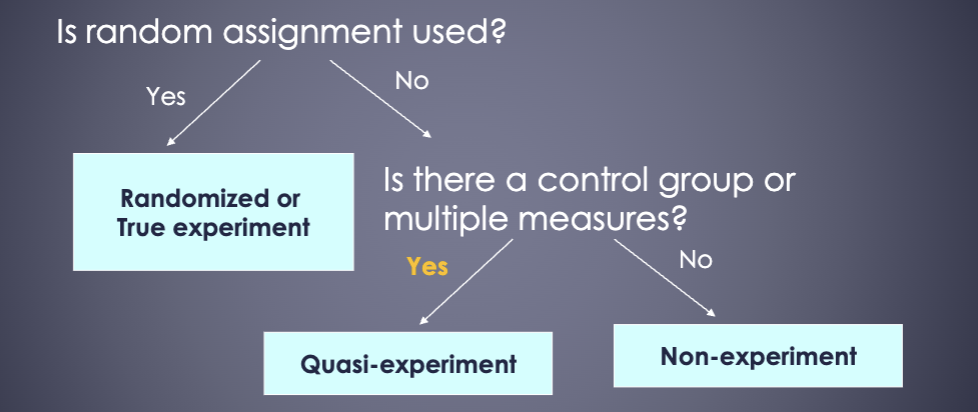quantitative research designs
1/52
There's no tags or description
Looks like no tags are added yet.
Name | Mastery | Learn | Test | Matching | Spaced |
|---|
No study sessions yet.
53 Terms
reasons for quantitate research designs
What are the components of a quant design?
– Survey
– Population and Sample
– Instruments and measures
› Data analysis and interpretation
– Correlation ≠ Causation
› Validity and Generalizability
criteria for inferring causality
– 1. Time sequence (The cause must precede the effect in
time.)
– 2. Correlation (Changes in the cause are accompanied by
changes in the effect.)
– 3. Ruling out alternative explanations
4. Strength of correlation
5. Consistency in replication
6. Plausibility and coherence
internal validity
refers to how well an experiment is done, especially whether it avoids confounding (more than one possible independent variable [cause] acting at the same time). The less chance for confounding in a study, the higher its internal validity is.
› Ruling out alternative explanations pertains to the internal validity of a study
internal validity regarding causal inference
– Internal validity – the confidence we have that the results accurately depict whether one variable is or is not the cause of the other
– External validity – refers to the extent to which we can generalize the findings
more on variable and internal validity
Extraneous variables are variables that may compete with the independent variable in explaining the outcome of a study.
› A confounding variable is an extraneous variable that does indeed influence the dependent variable.
› A confounding variable systematically varies or influences the independent variable and also influences the dependent variable.
› Researchers must always worry about extraneous variables when they make conclusions about cause and effect.
threats to internal validity
1. history
2. maturation or the passage of time
3. testing
4. instrumentation changes
5. statistical regression
6. selection biases
history
Did some unanticipated event occur while the experiment was in progress and did these events affect the dependent variable?
maturation
changes in DV due to normal developmental processes
instrument changes
did any change occur during the study in the way the DV was measured
statistical regression
An effect that is the result of a tendency for subjects selected on the bases of extreme scores to regress towards the mean on subsequent tests.
selection
selecting participants for the various groups in the study. Are the groups equivalent at the beginning of the study?
› Were subjects self-selected into experimental and comparison groups? This could affect the dependent variable.a
dditional threats
Measurement Bias
› People who supply the ratings of the groups should not know the experimental status of the participants
research reactivity
› Biasing comments by researchers
› Experimental demand characteristics and experimenter
expectancies
› Obtrusive observation
›. Novelty and disruption effects
› Placebo effects
experimental mortality, what is attrition?
participants iwll drop out of an experiment before it is completed, affecting statistical comparisons and conlcusions
to minimize attrition
1. provide reimbursement to participants
2. avoid intervention or research procedures that disappoint or frustrate
3. utilize tracking methods
two divisions of external validity
population validity
ecological validity
population validity
how representative is the sample of the population
how widely does the finding apply
ecological validity
Ecological validity is present to the degree that a result generalizes across settings. Types include:
– Interaction effect of testing
– Reactive effects of experimental arrangements
– Multiple-treatment interference
– Experimenter effects
threats to external validity
Interaction effect of testing: Pre-testing interacts with the experimental treatment and causes some effect such that the results will not generalize to an untested population.
Hawthorne effect
An effect that is due simply to the fact that subjects know that they are participating in an experiment and experiencing the novelty of it — the Hawthorne effect
multiple treatment interference
When the same subjects receive two or more treatments as in a repeated measures design, there may be a carryover effect between treatments such that the results cannot be generalized to single treatments
designs (two types)
pre-experimental and experimental
quantitative vs qualitative approaches to research
Quantitative: Testing objective theories by examining relationship among variables
› Qualitative: Exploring and understanding meaning individuals/groups ascribe to social or human problem
› Mixed-Methods: Collect Quant and Qual
pre-experimental pilot studies
Some have an exploratory or descriptive purpose and can have considerable value despite having a low degree of internal validity
– Despite their value as pilot studies, pre-experimental designs rank low on the evidence-based practice research hierarchy because of their negligible degree of internal validity
One-group pre-test-posttest design
establishes both correlation and time order
-this design assesses the dependent variable before and after the stimulus (intervention) is introduced; o1 x o2
this design doesn’t account for factors other than the IV that may have caused change
Post-test only design
x o
o
asses the DV after the stimulus is introduced for one group, while also assessing the DV for a second group that may not be comparable and was not exposed to the IV
Experimental Designs
try to control for threats to internal validity by randomly assigning research participants to experimental and control groups.
Next, they introduce one category of the independent variable to the experimental group, while withholding it from the control group
– Then, they compare the extent to which the experimental and control groups differ on the dependent variable
pre-test post-test control group design
R O1 X O2
R O1 O2
The R stands for random assignment of participants to either group; O1 represents pretests, and O2 represents posttests; X represents the tested intervention
Post test only control group
R X O
R O
might opt for if pretest has an impact
random assignment
Solomon Four-group design
R O1 X O2
R O1 O2
R X O2
R. O2
highly regarded, rarely used. Used when wanting to know amount of -pre/post test change but worried about testing effects. Logistically difficult.
alternative treatment design with pretest
compare effectiveness of two alternative treatments, with pretest.

dismantling studies
similar type of design can also determine which components of the intervention may or may not be necessary to achieve its effects
– The first row represents components A and B
– The second row represents treatment A only; the third row represents treatment B only
– The fourth row represents the control group
Randomization (random assignment) is not the same as random samplin
participants to be randomly assigned are
individuals who voluntarily agreed to participate in the
experiment, which limits the external validity
In randomization, research participants who make up the study population are randomly divided into two samples
matching
Although randomization is the best way to avoid bias in assigning research participants to groups, it does not guarantee full comparability
– One way to improve the chances of obtaining comparable groups is to combine randomization with matching:
– Pairs of participants are matched on the basis of their similarities on one or more variables
– one member of the pair is assigned to the experimental group, and one to
the control group
testing
A pre-test may sensitize participant in unanticipated ways and their performance on the post-test may be due to the pre-test, not to the treatment, or, more likely, and interaction of the pre-test and treatment.
› Example: In an experiment in which performance on a logical reasoning test is the dependent variable, a pre-test cues the subjects about the post-test.
Quasi-experimental designs
If random assignment is not used, but there is a control group or multiple measures, it is a quasi experiment

when do they help
when control groups and randomization is not feasible, say if withholding services is unethical
the nonequivalent groups design
The most frequently used in social research
› Try to select groups that are as similar as possible to
compare the treated one with the comparison one
– e.g. two comparable classrooms or schools
› Cannot be sure whether the groups are comparable?
– Require a pretest and posttest
Nonequivalent comparison groups design
These can be used when we are unable to randomly assign participants to groups, but can find an existing group that appears similar to the experimental group, and can be compared to it
ways to strengthen the internal validity of the nonequivalent ocmparison groups design
multiple pretests
switching replication (adminestering the treatment to the comparison group after the first posttest)
regression discontinuity design
A useful method for determining whether a program of treatment is effective
› Participants are assigned to program or comparison groups based on a cutoff score on a pretest
treatment can be given to those most in need
simple time-series designs
mphasize the use of
multiple posttests
– The simple interrupted time-series design does not
require a comparison group; notation:
O O O O O O X O O O O O O
multiple time series designs
greater internal validity,
an experimental group and a nonequivalent comparison group are measured at multiple points in time before and after an intervention
cross-sectional studies
A cross-sectional study examines a phenomenon by taking a cross section of it at one point in time
– Cross-sectional studies may have exploratory, descriptive or explanatory purpose
case control studies
A case control design study compares groups of cases that have had contrasting outcomes and collects retrospective data about past differences that might explain the difference in outcomes
– Can be fraught with problems that limit what can be inferred or generalized
› Memories could be faulty
› Recall bias
practical pitfalls in carrying out experiments and quasi experiments
is as follows
fidelity of the intervention
Refers to the degree to which the intervention
delivered to clients was delivered as intended
contamination of the control condition
Even if the intervention is delivered as intended, the control condition can be contaminated if control group and experimental group members interact
resistance to the case assignment protocol
Practitioners tend to believe their services are effective, so may not be committed to adhering to the research protocol, believing they know what is best for the client
client recruitment and retention
Recruiting a sufficient number can be difficult
when research must rely on referrals of clients from outside the agency
strengths of quasi experimental design
useful in generating results/trends for social sciences
easily integrated with indvidual case studies
reduces the time and resources required for experimentationw
weaknesses
lacks randomization
doesn’t explain pre-existing factors and influences outside of experiment
serious limitations in terms of validity
ongoing debate
Recruiting a sufficient number can be difficult when research must rely on referrals of clients from outside the agency